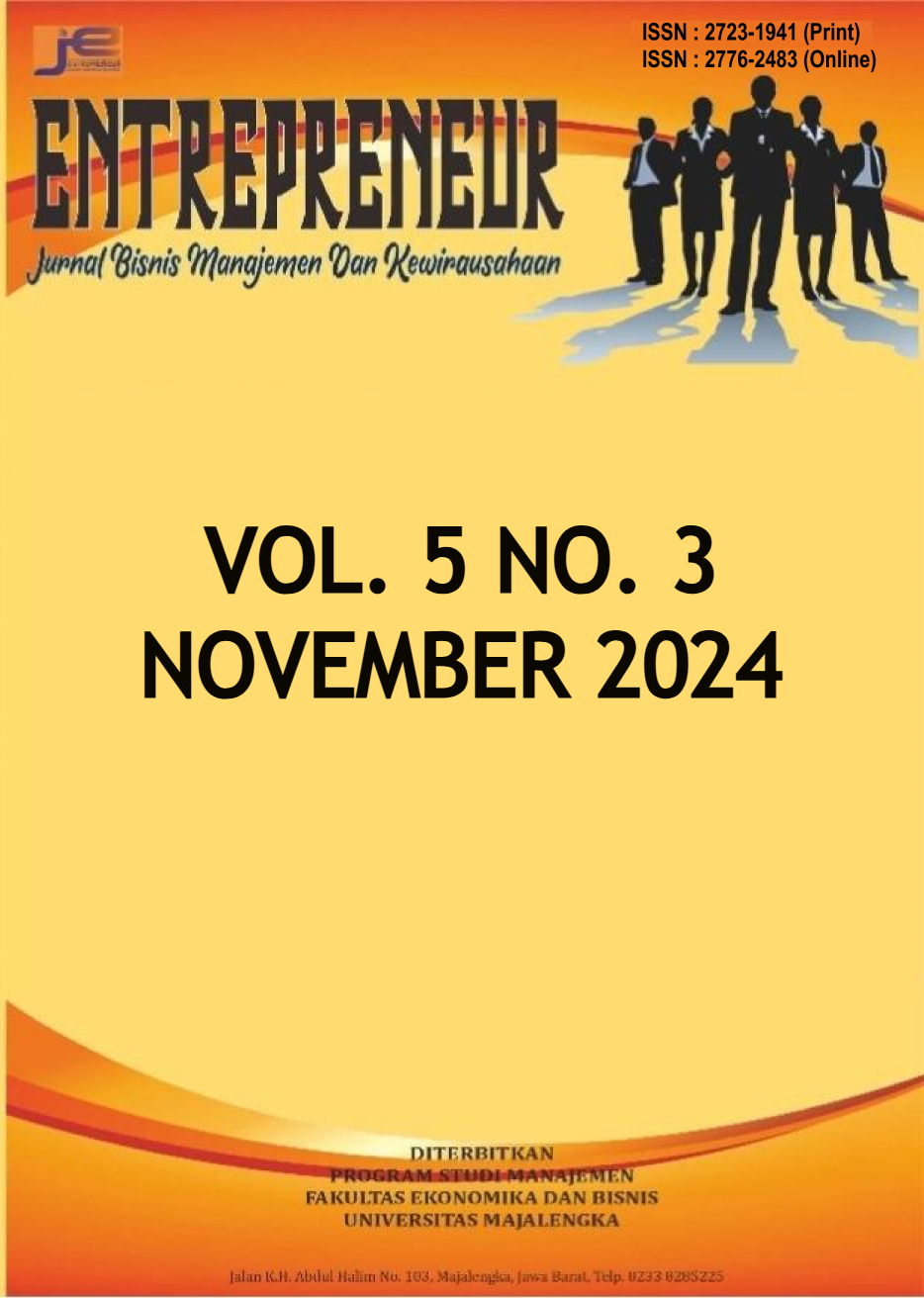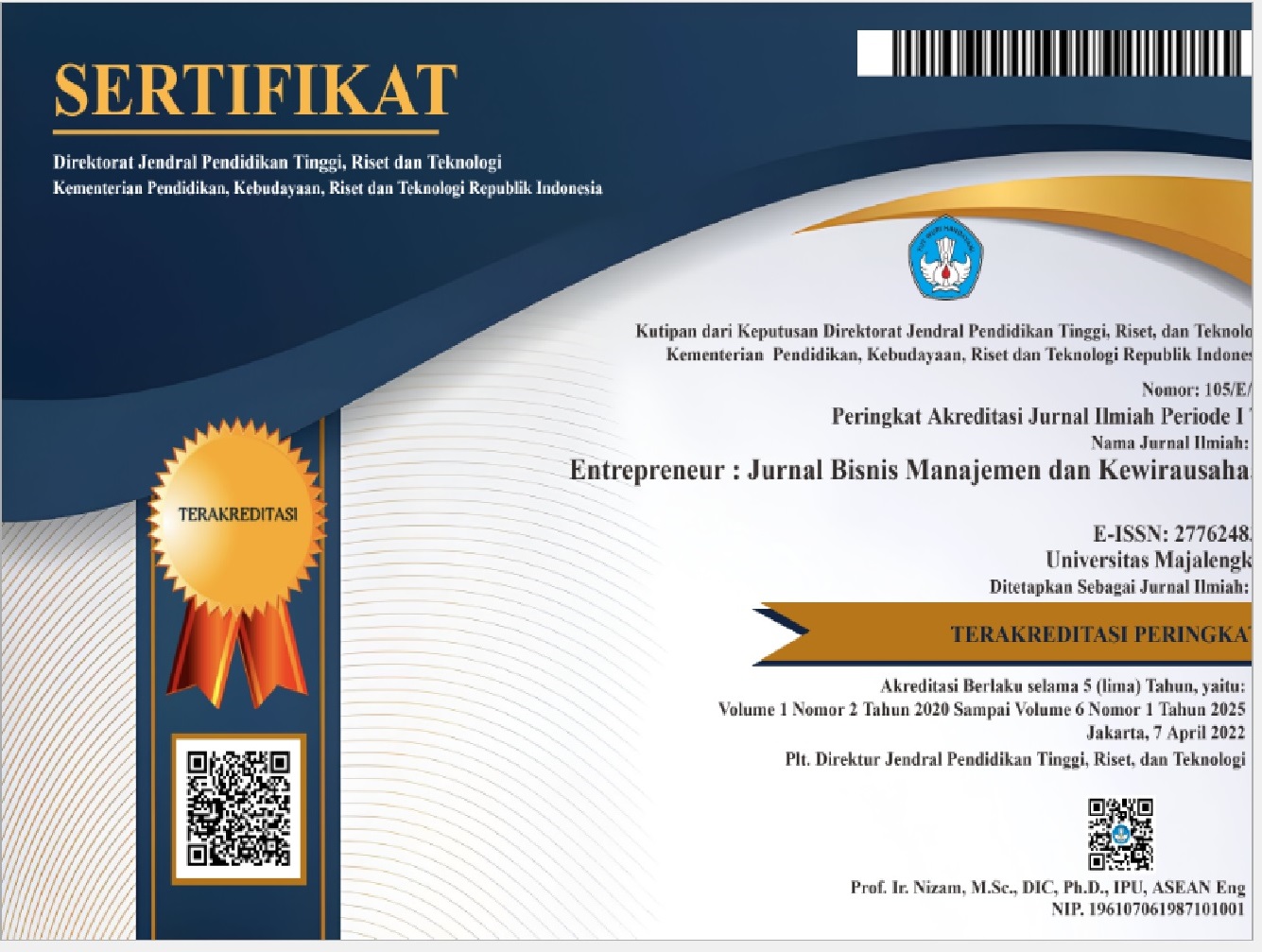Manajemen Pentahelix Dalam Pencegahan Dan Penaggulangan Terorisme Di Desa Kananga Kabupaten Bima
DOI:
https://doi.org/10.31949/entrepreneur.v5i3.11744Abstract
Terrorism is a crime that is now widely discussed in print and electronic media, especially in Indonesia, which has been seriously affected since the Bali Bombing I in 2002. To this day, acts of terrorism continue to occur in various forms, involving both individuals and groups. This study aims to analyze the implementation of the Penta helix concept in efforts to prevent and counter terrorism in Kananga Village, Bima Regency, as well as to identify the challenges encountered. This research employs a qualitative method with a case study approach involving informants representing the five elements of the Pentahelix: government, academia, business, community, and media. Informants were selected through purposive sampling, and data were collected through interviews, observations, and documentation. The study results show that applying the pentahelix concept through a culturally-based approach, education, and solidarity effectively maintains social harmony and prevents the community from being exposed to radicalism. However, the main challenges faced include a need for coordination among institutions, limited access to vulnerable communities, and negative perceptions from some community members toward these efforts. The study concludes that the Penta helix concept can create a positive synergy between the government, academia, business, community, and media. However, challenges in coordination and perception need to be addressed to maximize its effectiveness in preventing terrorism
Keywords:
Pentahelix, prevention, response, terrorismDownloads
References
Andayani. (2023). Strengthening Cultural Identity as a Resilience Factor Against Radicalization. Journal of Cultural Studies, 10(2), 123–138.
Dewi, A., & Y. (2023). Challenges in Community Participation in Terrorism Prevention Programs. Journal of Social Science Research, 15(2), 101–115.
Emerson, Kirk, Tina Nabatchi, S. B. (2011). An Integrative Framework for Collaborative Governance. Journal of Public Administration Research & Theory, 22(1).
Firmansyah. (2011). Upaya Penanggulangan Tindak Pidana Terorisme di Indonesia. Jurnal Mimbar Hukum, 23(2), 377–393.
Hadi, S., & K. (2024). Cultural Activities and Their Role in Mitigating Radicalization in Traditional Communities. Journal of Cultural Studies, 12(1), 75–90.
Harsono. (2023). The Effectiveness of the Pentahelix Approach in Mitigating Radical Ideologies. International Journal of Terrorism Prevention, 15(3), 201–215.
Hermawan, A., & Aryani, D. (2023). Structured Collaboration in Identifying Threats: A Case Study in Kananga Village. Journal of Community Safety, 8(1), 56–70.
Kurniawan, B. (2023). Enhancing Social Intervention Effectiveness Through NonState Sector Involvement in Pentahelix Collaboration. Indonesian Journal of Public Policy, 9(3), 200–214.
Lindmark, S. & R. (2009). Leaving Terrorism Behind: Individual and Collective Disengagement. Routledge.
Miles & Huberman. (1984). Qualitative Data Analysis a Sourcebook of New Methode. SAGE Publications, Inc.
Moleong, L. J. (2010). Metodologi Penelitian Kualitatif. PT Remaja Rosdakarya.
Monique. Aisy, Bilqis., Ibrahim, Dina., Intang, Khusnul., T. (2019). Penegakan Kontra Radikalisasi Melalui Media Sosial Oleh Pemerintah Dalam Menangkal Radikalisme. Jurnal Hukum Magnum Opus, 2(1), 1–8.
Muhammad Zulfikar, & A. (2020). Peran Badan Nasional Penanggulangan Terorisme dalam Pemberantasan Terorisme di Indonesia. Jurnal Pembangunan Hukum Indonesia, 2(1), 129–144.
Muladi. (2002). Hakekat Terorisme dan Beberapa Prinsip Pengaturan dalam Kriminalisasi. Jurnal Kriminologi Indonesia FISIP UI, 2(3), 22–30.
Prabowo. (2018). Implementasi Bela Negara untuk Wujud Nasionalisme. Jurnal Ilmiah CIVIS, 1(1), 18–31.
Reza, M., Pujo, W., Herlina J., Panji S., Widodo, & Bayu, A. (2023). Pencegahan Ancaman Penyebaran Radikalisme dan Terorisme oleh BNPT di Wilayah Kemaritiman Sebagai Upaya Pertahanan Negara Republik Indonesia. Jurnal Kewarganegaraan, 7(1), 204-212.
Salim. (2006). Teori & Paradigma Penelitian Sosial. Tiara Wacana.
Sanur, D. (2016). Upaya Penanggulangan Terorisme ISIS di Indonesia dalam Melindungi Keamanan Nasional. Jurnal Politica, 7(1), 25–47.
Sari, R., & P. (2022). The Role of Local Businesses and Media in Preventing Radicalization: A Pentahelix Perspective. Journal of Business and Community Engagement, 7(2), 77–89.
Shaw, M. (2008). International Law, Sixth Edition (Sixth). Cambridge University Press.
Sugiyono. (2018). Metode Penelitian Kuantitatif, Kualitatif, dan R&D. CV. Alfabeta.
Sugiyono. (2019). Metode Penelitian Kuantitatif, Kualitatif, dan R&D. Bandung. CV. Alfabeta.
Susilo, H., Rahmawati, I., & S. (2022). Nurturing National Values Through Education: Academic Contributions to Counter-Radicalization. Journal of Educational Research, 14(1), 45–61.
Suwardi, M., Rahman, F., & S. (2023). Cross-Sector Communication as a Key Factor in MultiElement Collaboration for Terrorism Prevention. International Journal of Terrorism Studies, 8(4), 45–58.
Syafa’at, M. A. (2003). Tindak Pidana Teror Belenggu Baru bagi Kebebasan” dalam Terorism, Definisi, Aksi dan Regulas. Imparsial.
Tamtinim, Ampuan., & I. (2023). Peran Badan Nasional Penanggulangan Terorisme (BNPT) dalam Menanggulangi Radikalisme dan Terorisme di Indonesia. Fundamental: Jurnal Ilmiah Hukum, 12(2), 354–383.
Wijaya, F., Utama, P., & L. (2022). Coordination Across Elements: Keys to Success in Pentahelix Models for Complex Issues. Journal of Public Policy Analysis, 11(3), 201–218.
Yanti, R. (2016). Tindak Pidana Terorisme Dari Perspektif Hukum Pidana Internasional. Jurnal Surya Kencana Dua: Dinamika Masalah Hukum Dan Keadilan, 3(1), 1–8.

Published
How to Cite
Issue
Section
License
Copyright (c) 2024 Muhammad Fuad, Umar, Najamudin

This work is licensed under a Creative Commons Attribution-ShareAlike 4.0 International License.
COPYRIGHT NOTICE
An author who publishes in the Entrepreneur: Jurnal Bisnis Manajemen dan Kewirausahaan agrees to the following terms:
1. Author retains the copyright and grants the journal the right of first publication of the work simultaneously licensed under the Creative Commons Attribution-ShareAlike 4.0 License that allows others to share the work with an acknowledgment of the work's authorship and initial publication in this journal
2. The author is able to enter into separate, additional contractual arrangements for the non-exclusive distribution of the journal's published version of the work (e.g., post it to an institutional repository or publish it in a book) with the acknowledgment of its initial publication in this journal.
3. The author is permitted and encouraged to post his/her work online (e.g., in institutional repositories or on their website) prior to and during the submission process, as it can lead to productive exchanges, as well as earlier and greater citation of the published work







